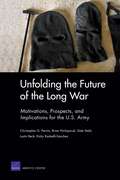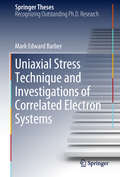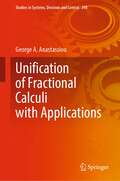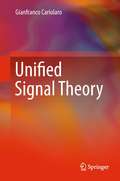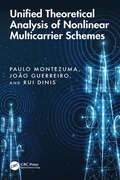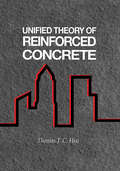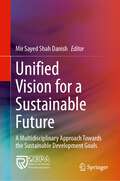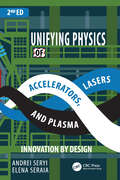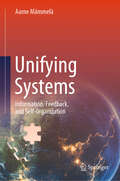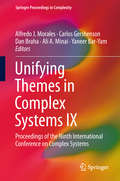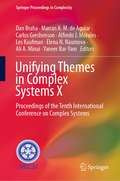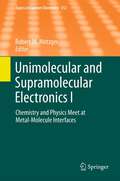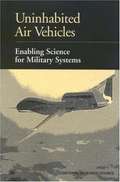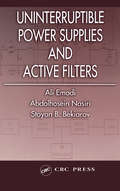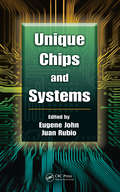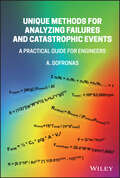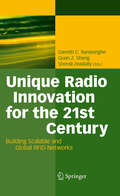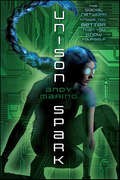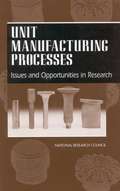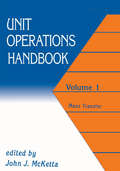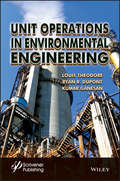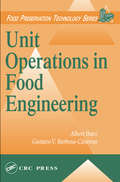- Table View
- List View
Unfolding the Future of the Long War: Motivations, Prospects, and Implications for the U. S. Army
by Brian Nichiporuk Christopher G. Pernin Justin Beck Dale Stahl Ricky Radaelli-SanchezThe United States is currently engaged in a military effort that has been characterized as the "long war." This study explores the concept of long war and identifies ways in which it might unfold as well as the implications for the Army and the U.S. military more generally. This report uses the generation of either "trajectories" or alternative paths in which the long war might unfold to explore the implications for the U.S. military.
Uniaxial Pressure Study of Charge Density Waves in a High-T꜀ Cuprate Superconductor (Springer Theses)
by Hun-ho KimThis book presents comprehensive studies of charge density waves (CDW) in a high-Tc cuprate superconductor using x-ray scattering techniques under uniaxial pressure. Specifically, the work addresses inelastic x-ray scattering studies under uniaxial pressure performed on the underdoped cuprate YBa2Cu3O6.67(p=0.12, Tc=65K) with incoming photon energy in the resonant (E=931.3 eV, Cu-L3 edge) and non-resonant conditions (E=17.794 keV). This is a completely new approach to the investigation of charge density waves. It revealed new features of charge density waves in cuprates, whose properties had previously been inaccessible..
Uniaxial Stress Technique and Investigations of Correlated Electron Systems (Springer Theses)
by Mark Edward BarberThis book reports on the development and application of a new uniaxial pressure apparatus that is currently generating considerable interest in the field of materials physics. The author provides practical guidelines for performing such experiments, backed up by finite element simulations. Subsequently, the book reports on two uses of the device. In the first, high pressures are used to tune to a Van Hove singularity in Sr2RuO4, while the effects on the unconventional superconductivity and the normal state properties are investigated. In the second experiment, precise and continuous strain control is used to probe symmetry breaking and novel phase formation in the vicinity of a quantum critical point in Sr3Ru2O7.
Unification of Fractional Calculi with Applications (Studies in Systems, Decision and Control #398)
by George A. AnastassiouThis book demonstrates the unifying methods of generalized versions of Hilfer, Prabhakar and Hilfer–Prabhakar fractional calculi, and we establish related unifying fractional integral inequalities of the following types: Iyengar, Landau, Polya, Ostrowski, Hilbert–Pachpatte, Hardy, Opial, Csiszar’s f-Divergence, self-adjoint operator and related to fuzziness. Our results are univariate and multivariate. This book’s results are expected to find applications in many areas of pure and applied mathematics, especially in fractional inequalities and fractional differential equations. Other interesting applications can be in applied sciences like geophysics, physics, chemistry, economics and engineering. This book is appropriate for researchers, graduate students, practitioners and seminars of the above disciplines, also to be in all science and engineering libraries.
Unified Signal Theory
by Gianfranco CariolaroUnified Signal Theory is an indispensible textbook dealing with the theory of deterministic signals; a topic of fundamental interest to graduates and senior undergraduates in the areas of information engineering (telecommunications, control, systems theory and electronics), astronomy, oceanography, earth science, biology and medicine. The unified theory follows an innovative approach - that of combining all signal classes into just one. The fundamental signal operations (convolution, Fourier transform, linear systems, sampling and interpolation) are established simultaneously for all the signal classes. This unified approach avoids the repetition of similar concepts consequent on other approaches' separate treatment of definitions and properties for each signal class. Modern wavelet ideas are developed in harmony with the rest of the text. Unified Signal Theory provides: * exercises and examples, to give the student practice; * solutions which are available for download and save the tutor time; and * a choice of two suggested reading paths depending on the level of the student, for an enhanced learning experience. The advantages of the unified approach are many: it permits a global vision of the topic, it is economical in teaching and learning, and it can be adjusted easily to fit new applications. This textbook presents the theory in five chapters, and goes on to demonstrate specific applications such as fast Fourier transform implementation, sampling and reconstructions of signals, and multicolor modulation systems, in a further six chapters. Mathematical concepts are introduced conceptually within the body of the book with more rigorous treatment being reserved for the appendices.
Unified Theoretical Analysis of Nonlinear Multicarrier Schemes
by Paulo Montezuma Rui Dinis João GuerreiroThis book provides the analytical tools to characterize nonlinear distorted multicarrier signals and optimal/sub-optimal receivers employed in high data rate communication systems.Unified Theoretical Analysis of Nonlinear Multicarrier Schemes introduces new optimal and sub-optimal receivers for nonlinear distorted signals that can use nonlinear distortion to improve performance when compared with common receivers. It addresses the analysis of nonlinear systems with stochastic inputs and establishes new receivers designs for multi-carrier communication systems with nonlinearities. The authors also include the characterization and definition of optimum and sub-optimum receivers for nonlinear distorted signals that may use the nonlinear distortion to improve receiver performance over the existing ones. The book also includes a set of applications where the analytical unified method for characterization of nonlinear distortion can be applied. The two final chapters of the book include systems like MIMO OFDM and the extension to optical systems. These techniques are the base of 5G, Wi-fi and future 6G mobile networks.The book will be a valuable resource for design engineers, industrial engineers, applications engineers and researchers working on multi-carrier systems, power amplifiers modelling and design.
Unified Theory of Reinforced Concrete (New Directions In Civil Engineering Ser. #5)
by Thomas T.C. HsuReinforced concrete structures are subjected to a complex variety of stresses and strains. The four basic actions are bending, axial load, shear, and torsion. Presently, there is no single comprehensive theory for reinforced concrete structural behavior that addresses all of these basic actions and their interactions. Furthermore, there is little consistency among countries around the world in their building codes, especially in the specifications for shear and torsion. Unified Theory of Reinforced Concrete addresses this serious problem by integrating available information with new research data, developing one unified theory of reinforced concrete behavior that embraces and accounts for all four basic actions and their combinations. The theory is presented in a systematic manner, elucidating its five component models from a pedagogical and historical perspective while emphasizing the fundamental principles of equilibrium, compatibility, and the constitutive laws of materials. The significance of relationships between models and their intrinsic consistencies are emphasized. This theory can serve as the foundation on which to build a universal design code that can be adopted internationally. In addition to frames, the book explains the fundamental concept of the design of wall-type and shell-type structures.Unified Theory of Reinforced Concrete will be an important reference for all engineers involved in the design of concrete structures. The book can also serve well as a text for a graduate course in structural engineering.
Unified Vision for a Sustainable Future: A Multidisciplinary Approach Towards the Sustainable Development Goals
by Mir Sayed Shah DanishUnified Vision for a Sustainable Future: A Multidisciplinary Approach Towards the Sustainable Development Goals focuses on energy and the environment, highlighting interdisciplinary research, innovative strategies, and global initiatives presented at the International Conference on Collaborative Endeavors for Global Sustainability (CEGS 2024). The book explores the various pillars of sustainability – environmental, social, institutional, technical, and economic – and provides readers with case studies, practical solutions, and models for the UN’s Sustainable Development Goals. The book further examines the implications of these initiatives, analyzing their potential for long-lasting, sustainable impact.This book will appeal to a broad readership. Academics, researchers, policymakers, sustainability advocates, and anyone interested in global sustainability will find the book insightful.
Unifying Electrical Engineering and Electronics Engineering: Proceedings of the 2012 International Conference on Electrical and Electronics Engineering
by Jingming Xia Song Xing Suting Chen Zhanming WeiUnifying Electrical Engineering and Electronics Engineering is based on the Proceedings of the 2012 International Conference on Electrical and Electronics Engineering (ICEE 2012). This book collects the peer reviewed papers presented at the conference. The aim of the conference is to unify the two areas of Electrical and Electronics Engineering. The book examines trends and techniques in the field as well as theories and applications. The editors have chosen to include the following topics; biotechnology, power engineering, superconductivity circuits, antennas technology, system architectures and telecommunication.
Unifying Physics of Accelerators, Lasers and Plasma
by Andrei Seryi Elena SeraiaUnifying Physics of Accelerators, Lasers and Plasma introduces the physics of accelerators, lasers and plasma in tandem with the industrial methodology of inventiveness, a technique that teaches that similar problems and solutions appear again and again in seemingly dissimilar disciplines. This unique approach builds bridges and enhances connections between the three aforementioned areas of physics that are essential for developing the next generation of accelerators. A Breakthrough by Design approach, introduced in the book as an amalgam of TRIZ inventive principles and laws of technical system evolution with the art of back-of-the-envelope estimations, via numerous examples and exercises discussed in the solution manual, will make you destined to invent. Unifying Physics of Accelerators, Lasers and Plasma outlines a path from idea to practical implementation of scientific and technological innovation. This second edition has been updated throughout, with new content on superconducting technology, energy recovery, polarization, various topics of advanced technology, etc., making it relevant for the Electron-Ion Collider project, as well as for advanced lights sources, including Free Electron Lasers with energy recovery. The book is suitable for students at the senior undergraduate and graduate levels, as well as for scientists and engineers interested in enhancing their abilities to work successfully on the development of the next generation of facilities, devices and scientific instruments manufactured from the synergy of accelerators, lasers and plasma. Key Features: Introduces the physics of accelerators, lasers, and plasma in tandem with the industrial methodology of inventiveness. Outlines a path from idea to practical implementation of scientific and technological innovation. Contains more than 380 illustrations and numerous end-of-chapter exercises. Solutions manual is included into the book. The ebook is published in full colour. Boasting more than 380 illustrations, this highly visual text: Employs TRIZ to amalgamate and link different areas of science Avoids heavy mathematics, using back-of-the-envelope calculations to convey key principles Introduces the Innovation by Design approach based an amalgam of TRIZ inventive principles and laws of technical system evolution with the art of back-of-the-envelope estimations – developing and applying this methodology, you will be destined to invent Includes updated materials for all eleven chapters of the first edition, e.g., the FEL invention path analysis, etc. The second edition includes new chapters: Beam Cooling and Final Focusing, Beam Stability and Energy Recovery, Advanced Technologies The new chapters add topics such as superconducting magnets and accelerating cavities, polarized beams, energy recovery – themes relevant for new projects such as Electron-Ion Collider, or Free Electron Laser based on energy recovery for science or industry The second edition also includes a new chapter with illustrations of 40 inventive principles of TRIZ based on the areas of accelerator, laser and plasma technology Every chapter includes invention case studies, often making important connections to adjacent areas of technologies, illustrated by the case of EUV light generation invention for semiconductor lithography, etc. Includes end-of-chapter exercises focusing on physics and on applications of the inventiveness method, on reinventing technical systems and on practicing back-of-the-envelope estimations; and also includes mini-projects, suitable for exercises by teams of students Includes a detailed Guide to solutions of the exercises,
Unifying Systems: Information, Feedback, and Self-Organization
by Aarne MämmeläInterdisciplinary systems thinking is complementary but does not replace conventional disciplinary analytical thinking. The book is valuable for researchers, their advisors, and other thinkers interested in deep knowledge of science. Interdisciplinary systems thinking is valuable for three reasons: The goal of all science is a unified view of the world; we cannot solve the significant problems of our time without interdisciplinary collaboration; and general theories of systems and system archetypes support the solution to those problems. System archetypes are generic system models that have stood the test of time. As specialists within a discipline, we must be able to communicate between disciplines. Interdisciplinary generalists can offer us reliable visions and relevant research problems. The goal of interdisciplinary research is to find unified solutions to those problems. The book provides a lot of information from over a thousand sources in a structured manner to help the reader. The book includes a comprehensive chronology, vocabulary, and bibliography. The author has been a research professor in information engineering for over 25 years. During his career, he became interested in systems thinking, which is closely related to the philosophy and history of science.
Unifying Themes in Complex Systems IX: Proceedings of the Ninth International Conference on Complex Systems (Springer Proceedings in Complexity)
by Yaneer Bar-Yam Ali A. Minai Alfredo J. Morales Carlos Gershenson Dan BrahaUnifying Themes in Complex Systems is a well-established series of carefully edited conference proceedings that serve to document and archive the progress made regarding cross-fertilization in this field. The International Conference on Complex Systems (ICCS) creates a unique atmosphere for scientists from all fields, engineers, physicians, executives, and a host of other professionals, allowing them to explore common themes and applications of complex systems science. With this new volume, Unifying Themes in Complex Systems continues to establish common ground between the wide-ranging domains of complex systems science.
Unifying Themes in Complex Systems X: Proceedings of the Tenth International Conference on Complex Systems (Springer Proceedings in Complexity)
by Les Kaufman Yaneer Bar-Yam Ali A. Minai Alfredo J. Morales Carlos Gershenson Dan Braha Marcus A. M. de Aguiar Elena N. NaumovaThe International Conference on Complex Systems (ICCS) offers a unique interdisciplinary venue for researchers from the physical and biological sciences, social sciences, psychology and cognitive science, engineering, medicine, human systems, and global systems. This proceedings volume gathers selected papers from the conference. The New England Complex Systems Institute (NECSI) has been instrumental in the development of complex systems science and its applications. NECSI pursues research, education, knowledge dissemination, and community development efforts around the world to promote the study of complex systems and its application for the benefit of society. NECSI hosts the International Conference on Complex Systems and publishes the NECSI Book.
Unimolecular and Supramolecular Electronics II
by Robert M. MetzgerMolecular Electronic Junction Transport: Some Pathways and Some Ideas, by Gemma C. Solomon, Carmen Herrmann and Mark A. Ratner Unimolecular Electronic Devices, by Robert M. Metzger and Daniell L. Mattern Active and Non-Active Large-Area Metal-Molecules-Metal Junctions, by Barbara Branchi, Felice C. Simeone and Maria A. Rampi Charge Transport in Single Molecular Junctions at the Solid/Liquid Interface, by Chen Li, Artem Mishchenko and Thomas Wandlowski Tunneling Spectroscopy of Organic Monolayers and Single Molecules, by K. W. Hipps Single Molecule Logical Devices, by Nicolas Renaud, Mohamed Hliwa and Christian Joachim
Uninhabited Air Vehicles: Enabling Science for Military Systems
by Committee on Materials Structures Aeronautics for Advanced Uninhabited Air VehiclesU.S. Air Force (USAF) planners have envisioned that uninhabited air vehicles (UAVs), working in concert with inhabited vehicles, will become an integral part of the future force structure. Current plans are based on the premise that UAVs have the potential to augment, or even replace, inhabited aircraft in a variety of missions. However, UAV technologies must be better understood before they will be accepted as an alternative to inhabited aircraft on the battlefield. The U.S. Air Force Office of Scientific Research (AFOSR) requested that the National Research Council, through the National Materials Advisory Board and the Aeronautics and Space Engineering Board, identify long-term research opportunities for supporting the development of technologies for UAVs. The objectives of the study were to identify technological developments that would improve the performance and reliability of “generation-after-next” UAVs at lower cost and to recommend areas of fundamental research in materials, structures, and aeronautical technologies. The study focused on innovations in technology that would “leapfrog” current technology development and would be ready for scaling-up in the post-2010 time frame (i.e., ready for use on aircraft by 2025).
Unintended Consequences of Renewable Energy
by Otto AndersenEnergy technologies in the future will need to be based on renewable sources of energy and will, ultimately, need to be sustainable. This book provides insight into unintended, negative impacts and how they can be avoided. In order to steer away from the pitfalls and unintended effects, it is essential that the necessary knowledge is available to the developers and decision makers engaged in renewable energy. The value of this book lies in its presentation of the unintended health and environmental impacts from renewable energies. The book presents results from cross-disciplinary research on the implementation of alternative fuels in the transport sector, namely hydrogen, electricity and biodiesel. This is followed by an assessment of environmental impacts from the production of solar cells. Critical reviews on the use of nanotechnology and nanomaterials in the energy technologies is then provided, with the formation of nanoparticles during combustion of bio-blended diesel and their toxic effects, discussed in detail.
Uninterruptible Power Supplies and Active Filters (Power Electronics and Applications Series)
by Ali Emadi Abdolhosein Nasiri Stoyan B. BekiarovAs industry power demands become increasingly sensitive, power quality distortion becomes a critical issue. The recent increase in nonlinear loads drawing non-sinusoidal currents has seen the introduction of various tools to manage the clean delivery of power. Power demands of medical facilities, data storage and information systems, emergency equipment, etc. require uninterrupted, high quality power. Uninterruptible power supplies (UPS) and active filters provide this delivery.The first to treat these power management tools together in a comprehensive discussion, Uninterruptible Power Supplies and Active Filters compares the similarities of UPS, active filters, and unified power quality conditioners. The book features a description of low-cost and reduced-parts configurations presented for the first time in any publication, along with a presentation of advanced digital controllers. These configurations are vital as industries seek to reduce the cost of power management in their operations.As this field of power management technology continues to grow, industry and academia will come to rely upon the comprehensive treatment found within this book. Industrial engineers in power quality, circuits and devices, and aerospace engineers as well as graduate students will find this a complete and insightful resource for studying and applying the tools of this rapidly developing field.
Unique Chips and Systems (Computer Engineering Series)
by Eugene John Juan RubioWhich came first, the system or the chip? While integrated circuits enable technology for the modern information age, computing, communication, and network chips fuel it. As soon as the integration ability of modern semiconductor technology offers presents opportunities, issues in power consumption, reliability, and form-factor present challenges. The demands of emerging software applications can only be met with unique systems and chips. Drawing on contributors from academia, research, and industry, Unique Systems and Chips explores unique approaches to designing future computing and communication chips and systems.The book focuses on specialized hardware and systems as opposed to general-purpose chips and systems. It covers early conception and simulation, mid-development, application, testing, and performance. The chapter authors introduce new ideas and innovations in unique aspects of chips and system design, then go on to provide in-depth analysis of these ideas. They explore ways in which these chips and systems may be used in further designs or products, spurring innovations beyond the intended scopes of those presented. International in flavor, the book brings industrial and academic perspectives into focus by presenting the full spectrum of applications of chips and systems.
Unique Methods for Analyzing Failures and Catastrophic Events: A Practical Guide for Engineers
by Anthony SofronasA practical and accessible approach to machinery troubleshooting Unique Methods for Analyzing Failures and Catastrophic Events is designed to assist practicing engineers address design and fabrication problems in manufacturing equipment to support safe process operation. Throughout the book, a wealth of real-world case studies and easy-to-understand illustrated examples demonstrate how to use simplified failure analysis methods to produce insights for a wide range of engineering problems. Dr. Anthony Sofronas draws from his five decades of industry experience to help engineers better understand the science behind a particular problem, evaluate the failure analysis of an outside consultant, and recommend the best path forward to management. The author distills sophisticated engineering analysis approaches into compact, user-friendly methodologies that can be easily applied to the readers’ own situations to avoid costly failures. Each chapter includes a thorough summary of the topic, relatable technical examples, and a concluding section with key takeaways and expert tips and advice. This invaluable guide: Helps readers make better decisions while solving complex engineering problems Provides numerous illustrated examples from engineering and science that can be used to develop real-world solutions Features detailed descriptions of both basic and advanced engineering analysis techniques Covers essential technical subjects that facilitate safe facility design and effective troubleshootingUnique Methods for Analyzing Failures and Catastrophic Events: An Illustrated Guide for Engineers is a must-have for chemical, petroleum, and mechanical engineers, reliability managers and technicians, design contractors, and maintenance workers working in process industries.
Unique Radio Innovation for the 21st Century
by Quan Z. Sheng Damith C. Ranasinghe Sherali ZeadallyAre you an engineer or a researcher developing RFID systems? Are you a manager considering deploying RFID-based applications? If so, this book is for you. Covering modern RFID systems, the challenges to RFID implementation are addressed using specific industrial research examples and common integration issues. The primary focus is on answering questions surrounding building scalable global Internet-based RFID networks. Key topics include RFID data management, RFID data processing and integration, Real-Time Locating Systems (RTLS) and sensors. The book considers the challenges of and solutions to building and exploiting global networks to guarantee one of the most important business drivers for modern RFID technology: traceability. The authors have drawn together RFID applications from the retail supply chain, asset and product lifecycle management, anti-counterfeiting and cold chain management to explore how global traceability networks can be created using RFID and sensor technologies. They present insights from world's leading research laboratories.
Unison Spark
by Andy MarinoEveryone is obsessed with Unison, the social network that knows you better than you know yourself. Everyone who can afford it, that is. Living beneath the vast ceiling that separates Eastern Seaboard City into rich topside and poor sub-canopy zones, fifteen-year-old Mistletoe can only dream of logging in and has to make do with technological hand-me-downs.Worlds collide when Ambrose Truax, the privileged heir to the Unison empire, wanders into the dangerous sub-canopy streets and Mistletoe saves him from suspicious, uniformed men. They soon discover that they share eerily similar dreams, hinting at a significant past.Together, Ambrose and Mistletoe begin to unravel the mystery of their identities and learn that they're pawns in a bigger game: the Unison 3.0 upgrade, a whole new kind of Friendship.
Unit Manufacturing Processes: Issues and Opportunities in Research
by Unit Manufacturing Process Research CommitteeManufacturing, reduced to its simplest form, involves the sequencing of product forms through a number of different processes. Each individual step, known as an unit manufacturing process, can be viewed as the fundamental building block of a nation's manufacturing capability. A committee of the National Research Council has prepared a report to help define national priorities for research in unit processes. It contains an organizing framework for unit process families, criteria for determining the criticality of a process or manufacturing technology, examples of research opportunities, and a prioritized list of enabling technologies that can lead to the manufacture of products of superior quality at competitive costs. The study was performed under the sponsorship of the National Science Foundation and the Defense Department's Manufacturing Technology Program.
Unit Operations Handbook: Volume 1 (In Two Volumes)
by McKetta John J.Emphasizes the design, control and functioning of various unit operations - offering shortcut methods of calculation along with computer and nomographic solution techniques. Provides practical sections on conversion to and from SI units and cost indexes for quick updating of all cost information.;This book is designed for mechanical, chemical, process design, project, and materials engineers and continuing-education courses in these disciplines.
Unit Operations in Environmental Engineering
by Louis Theodore R. Ryan Dupont Kumar GanesanThe authors have written a practical introductory text exploring the theory and applications of unit operations for environmental engineers that is a comprehensive update to Linvil Rich’s 1961 classic work, “Unit Operations in Sanitary Engineering”. The book is designed to serve as a training tool for those individuals pursuing degrees that include courses on unit operations. Although the literature is inundated with publications in this area emphasizing theory and theoretical derivations, the goal of this book is to present the subject from a strictly pragmatic introductory point-of-view, particularly for those individuals involved with environmental engineering. This book is concerned with unit operations, fluid flow, heat transfer, and mass transfer. Unit operations, by definition, are physical processes although there are some that include chemical and biological reactions. The unit operations approach allows both the practicing engineer and student to compartmentalize the various operations that constitute a process, and emphasizes introductory engineering principles so that the reader can then satisfactorily predict the performance of the various unit operation equipment.
Unit Operations in Food Engineering (Food Preservation Technology)
by Albert Ibarz Gustavo V. Barbosa-CanovasIn order to successfully produce food products with maximum quality, each stage of processing must be well-designed. Unit Operations in Food Engineering systematically presents the basic information necessary to design food processes and the equipment needed to carry them out. It covers the most common food engineering unit operations in detail, in
